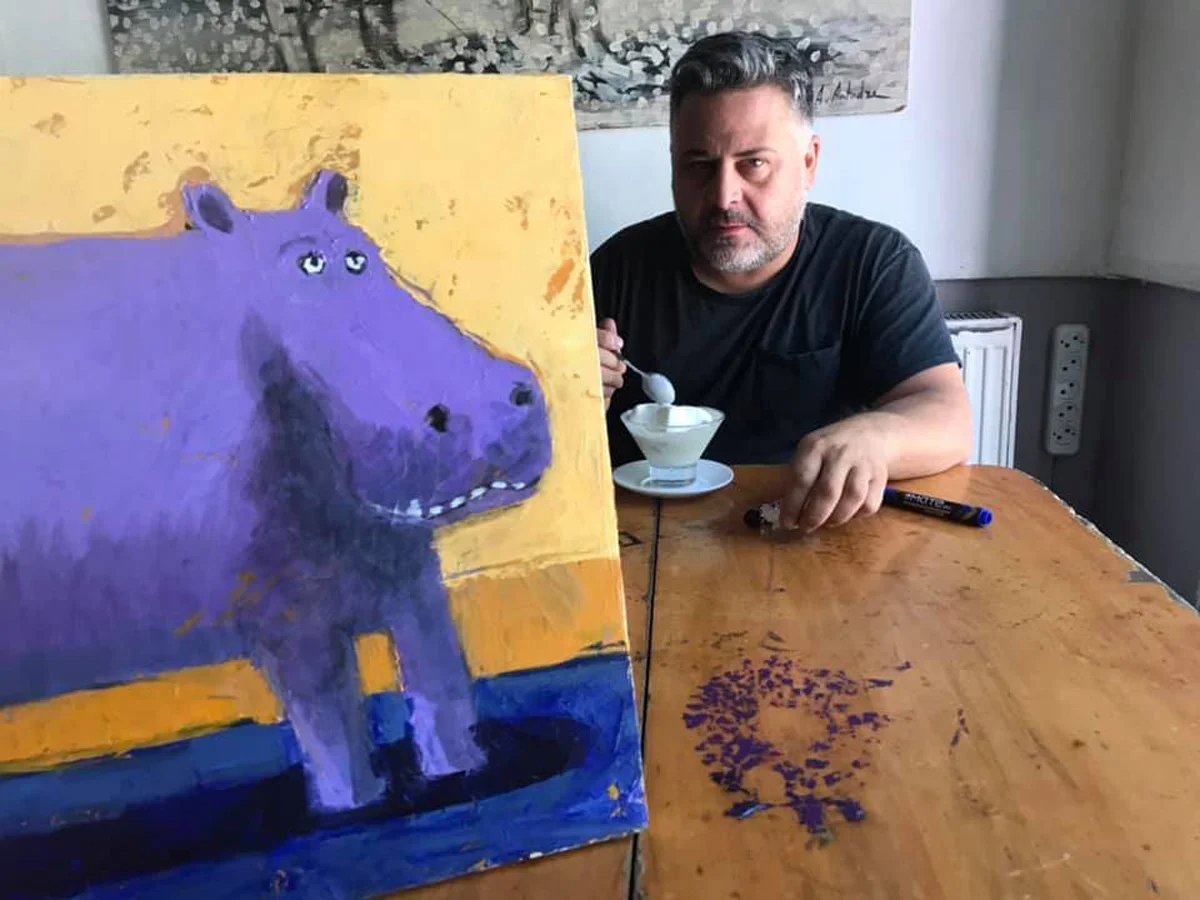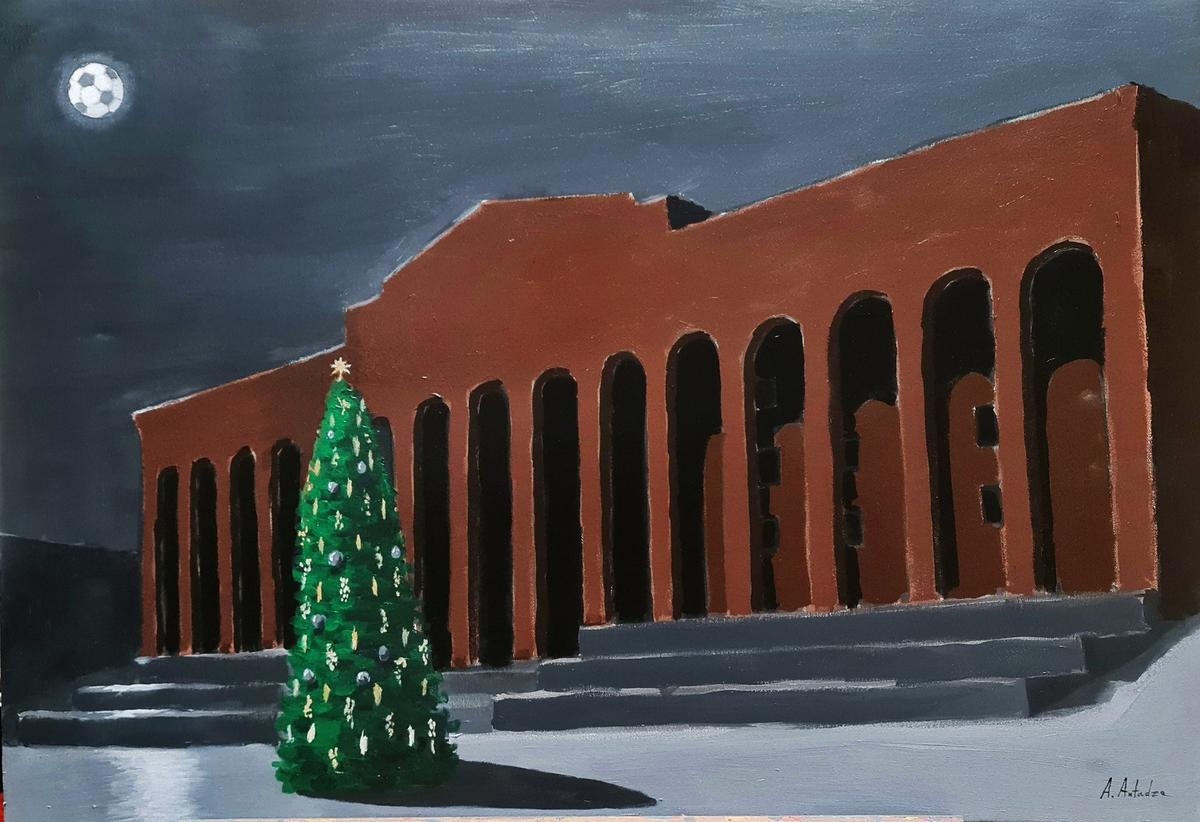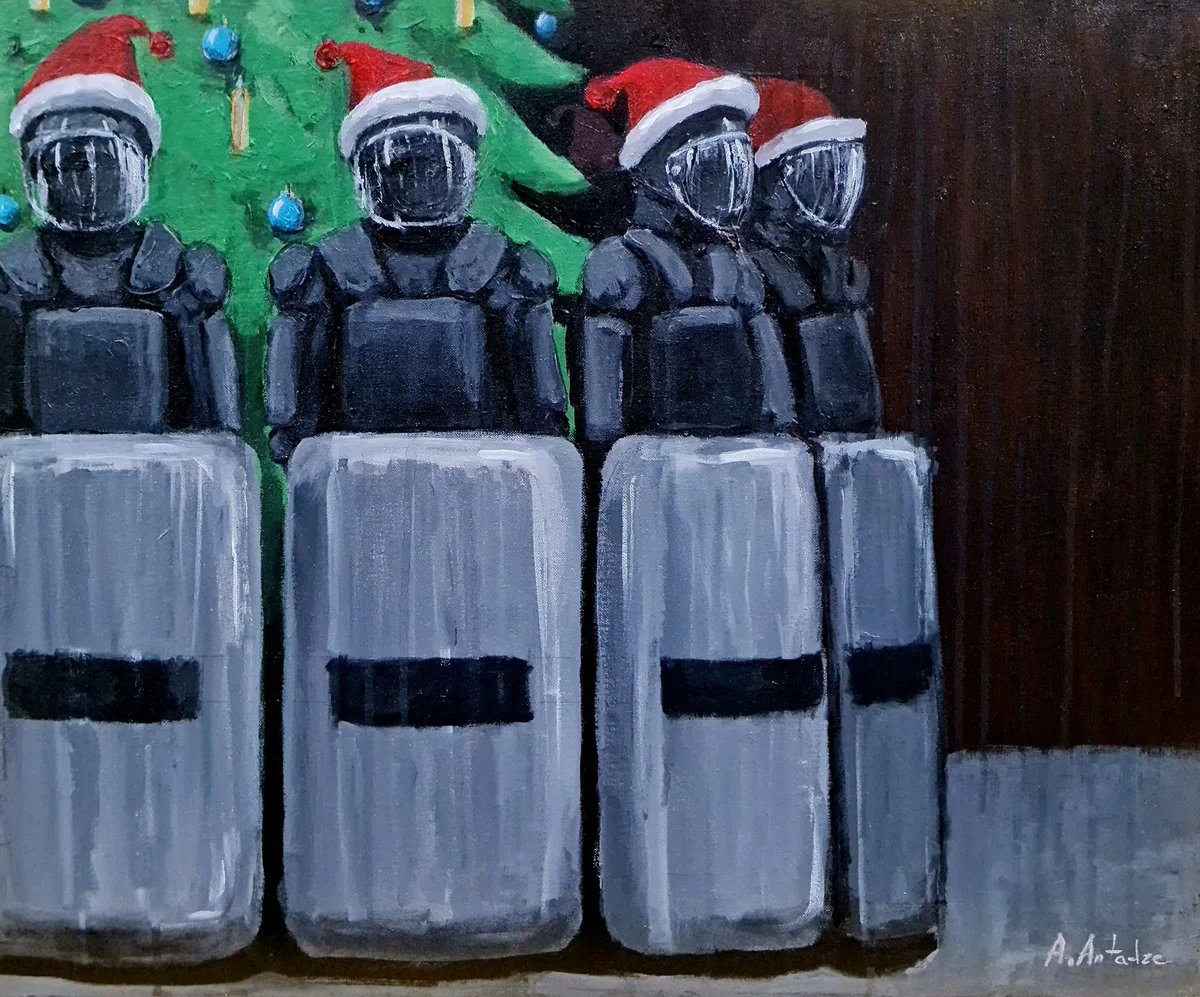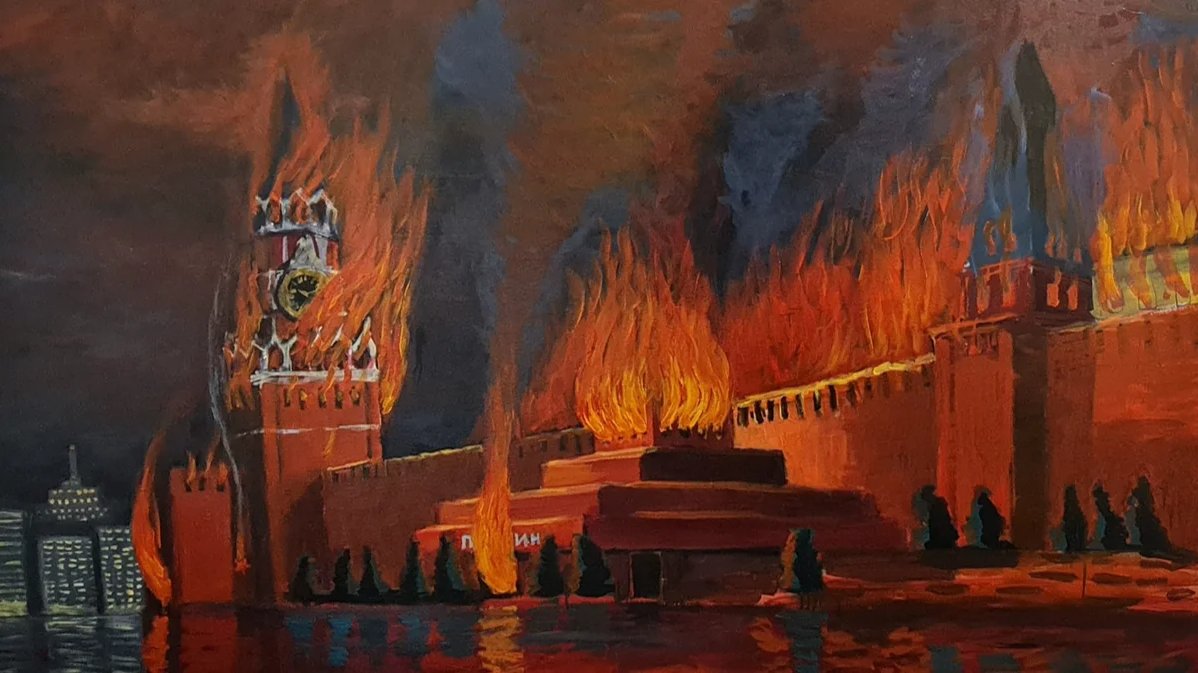A photograph of Ukrainian President Volodymyr Zelensky posing in front of Sandro Antadze’s painting of the Kremlin and Lenin’s Mausoleum engulfed in flames caused quite the stir in Moscow when it was published in Time Magazine last month. Novaya Gazeta Europe paints a portrait of its creator.
‘Not museum pieces’
In a recent article for Time Magazine, American journalist Simon Shuster described the Ukrainian president’s private office in Kyiv as “a space that feels like home to Zelensky — a small room with a single bed and a set of paintings that he chose himself”.
The paintings, which “might fetch a few hundred dollars at most” at the local bazaar but which are certainly “not museum pieces”, nevertheless “matter to the president because of what they represent”, Shuster wrote, and he should know, having written last year’s authorised biography of Zelensky, The Showman.
One painting hanging above the bed depicts a Russian warship sinking in the Black Sea. A second shows Ukrainian troops fighting on Russian soil. A third painting, in which the Kremlin is depicted engulfed in flames, is Zelensky’s favourite, according to Shuster, who quotes Zelensky saying “Each one’s about victory. That’s where I live.”
The photo of Zelensky standing in front of the third painting somehow managed to trigger uproar in Moscow in the days following its publication, despite the fact that the Kremlin is still in one piece, whereas Ukraine has been subjected to daily shelling, missile and drone strikes for the past three years.
Reacting to the image, Russian Foreign Ministry spokesperson Maria Zakharova commented succinctly “madhouse”, while Mikhail Sheremet, a deputy in Russia’s State Duma, also suggested that Zelensky seemed “to have gone crazy”.
Called the painting “sheer idiocy”, Senator Vladimir Dzhabarov of the ruling United Russia party insisted “it wouldn’t occur to anyone to commission a picture of a burning Khreshchatyk”, referring to Kyiv’s main avenue, though arguably the reason nobody paints the aftermath of missile strikes on Kyiv is that there are plenty of photographs available.
The stuff of dreams
Radiating kindness and looking more like a teddy bear than someone who wants to burn the Kremlin to the ground, Sandro Antadze, 53, is unremarkable looking with nothing immediately setting him apart from the crowd in the way he looks or speaks.
In the course of an interview with Georgian TV channel Formula, Antadze appears to struggle when asked what he wanted to express by painting the picture, saying only that the Kremlin painting had “made a strong impression on him” and that he had immediately named it The Dream. Most importantly, he stresses, the fire in the picture is a symbolic one.
“It has nothing to do with the Russian people,” Antadze says. “On the left of the painting, behind the Kremlin, there are houses that have their lights on to show that this isn’t about the people.”

Sandro Antadze, 2019. Photo: Irakli Gaprindashvili / Facebook
“I don’t want Moscow to go up in flames, killing millions. … This is a symbolic fire, as a critique of politics … And then there’s Lenin in his mausoleum. I don’t know why he is being kept like a Pharaoh in a pyramid in the 21st century, like some kind of deity, while they claim to be Orthodox Christians. In Georgia we think of Russians as our co-religionists, but they have this mausoleum that’s like the cult of Mao Zedong in China.”
Despite the fact that Antadze has painted a whole series of paintings depicting the Kremlin engulfed in flames, he insists he is “a very peaceful person who does not want war at all. But when I see injustice, when whole countries and millions of people suffer because of an insatiable empire, then I think this reaction is entirely justified.”
“Russia’s invasion of Ukraine was a huge blow to everyone, including to me personally. Russia seems unable to give up its role as an occupier and an aggressor. Despite the fact that Russia is huge, it still wants more. In Georgia, we have suffered the consequences of this policy for many years,” he adds. “My painting reflects the pain and bitterness that have built up over many years.”
Having trained to be an architect, Antadze’s first big break in the art world came in the 1990s when he won a trip to London in a skiing competition. Having taken 20 of his smaller paintings with him to the UK in case he needed “to barter them for food”, he actually ended up showing them at one of London’s most prestigious galleries, where all of them sold.
Having returned to Tbilisi, Antadze opened Cafe Gallery, a Bohemian bar and club in a historic two-storey building on the city’s main Rustaveli Avenue. The venue, where the Georgian underground thrives to this day, holds art exhibitions, as well as queer-friendly parties. Since then, Antadze has never stopped painting, and exhibits of his work have taken him all over the world, including to Russia until 2008, when Russia invaded Georgia.
His three best-known series of paintings are: Positivism, Living Objects, and Everything is Changing, the latter featuring depictions of old watches and armchairs, large TVs, rotary phones and other obsolete items. So his depiction of a Kremlin engulfed in flames may well have come as a surprise given the previous use of humour and nostalgia in his work.
Letter to Zelensky
“It’s very different from my usual style,” Antadze agrees of the painting, before adding that he felt it had “a mystical purpose, it was meant to make something happen”. Asking himself where the painting might best be displayed and who should be looking at it, he recalls having “the ambitious idea of sending it to Kyiv, to the government of Ukraine, to Zelensky. I decided that was the best place for it.”
“I wrote a post, asking if anyone had a way of getting in touch with Zelensky, as I wanted to send him a painting. The war had just begun at this point. I had no hope that the mail would work, but I posted the painting anyway. It would take a very long time to reach its destination and I was willing to accept that it might get lost en route and never be delivered. But it was important to try.”

Antadze’s 2024 depiction of the Georgian Parliament. Photo: Sandro Antadze
Eventually, Antadze was informed that his picture had reached someone in the Presidential Administration. “I didn’t even know if Zelensky had seen it. I decided not to worry too much about it and thought the administration had probably just put it in a corner."
Two years passed, and at the start of 2024, a friend sent Sandro a video of Zelensky delivering his New Year message, at the end of which The Dream can clearly be seen. As it comes into shot, Zelensky says: “Whoever brings hell to our land will one day see the same hell from his window.”
“I was amazed at how accurately Zelensky conveyed the message of what I had painted. It was incredible! My absurd idea had become something much more important. I still get goosebumps when I think about what happened,” Antadze says of knowing his painting is on permanent display in Zelensky’s office.
“The terrible repression will end someday, and Russia will become a kinder country.”
In his more recent paintings, Antadze has taken his inspiration from Georgian politics and in particular from the nightly protests on Rustaveli Avenue against the government’s sudden pro-Moscow stance and increasingly authoritarian behaviour.
In one, we see the parliament building bathed in darkness, with the moon in the night sky replaced by a football, in a nod to the recent appointment of former professional footballer Mikheil Kavelashvili to be Georgia’s president.

Georgian police guard a Christmas tree in an Antadze painting. Photo: Sandro Antadze
There is also a black and white Themis, the Greek goddess of justice, holding broken scales and a police baton, while another features an ominous painting of policemen dressed as Santa Claus, guarding a Christmas tree from demonstrators, a reference to a similar incident that took place outside the parliament building.
Antadze says he has a European mindset, and that Georgia is a European country, but that what is currently taking place in his country “has Russia written all over it”, predicting that his now world-famous painting would likely come true when the Russian political situation goes up in flames.
“I think only the Russians themselves can make that happen. I want to believe that this painting is also for them. Maybe it offended some people, but I think there’s a lot of dissatisfaction among the Russian people due to the policies of their government,” Antadze says.
“The terrible repression will end someday, and Russia will become a kinder country. I still have my doubts, of course, but I can hope and dream that we too will get out of the swamp that Russia is trying to drag us into.”
Join us in rebuilding Novaya Gazeta Europe
The Russian government has banned independent media. We were forced to leave our country in order to keep doing our job, telling our readers about what is going on Russia, Ukraine and Europe.
We will continue fighting against warfare and dictatorship. We believe that freedom of speech is the most efficient antidote against tyranny. Support us financially to help us fight for peace and freedom.
By clicking the Support button, you agree to the processing of your personal data.
To cancel a regular donation, please write to [email protected]

